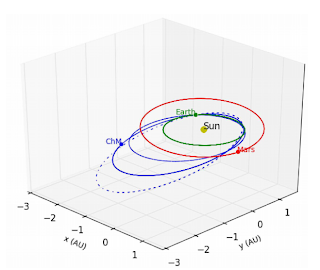TECHNOLOGY REVIEW: On 15 February at 0920 local time, a huge fireball raced across the skies above the Chelyabinsk region of Russia. This meteorite then exploded creating a shock wave that injured more than 1000 people.
Today, Jorge Zuluaga and Ignacio Ferrin at the University of Antioquia in Medellin, Colombia, take this approach a step further by reconstructing the meteorite’s original orbit around the Sun.
Calculating the rock’s orbit around the Sun is a more complicated affair. This depends on six critical parameters which must all be estimated from the data. Most of these are related to the point at which the meteorite becomes bright enough to cast a noticeable shadow in the videos, its ‘brightening point’. They include the meteorite’s height, elevation and azimuth at this point as well as the longitude and latitude on the Earth’s surface below. The velocity is also crucial.
“According to our estimations, the Chelyabinski meteor started to brighten up when it was between 32 and 47 km up in the atmosphere,” say Zuluaga and Ferrin, who estimate the velocity at between 13 km/s and 19 km/s relative to Earth.
Their conclusion is that the Chelyabinsk meteorite is from a family of rocks that cross Earth’s orbit called Apollo asteroids.
These are well known Earth-crossers. Astronomers have seen over 240 that are larger than 1 km but believe there must be more than 2000 others of similar size out there.
Smaller Earth crossers are even more common. The sobering news is that astronomers think there are some 80 million about the same size as the one that hit Russia.
Physics arXiv: A preliminary reconstruction of the orbit of the Chelyabinsk Meteoroid

Comments